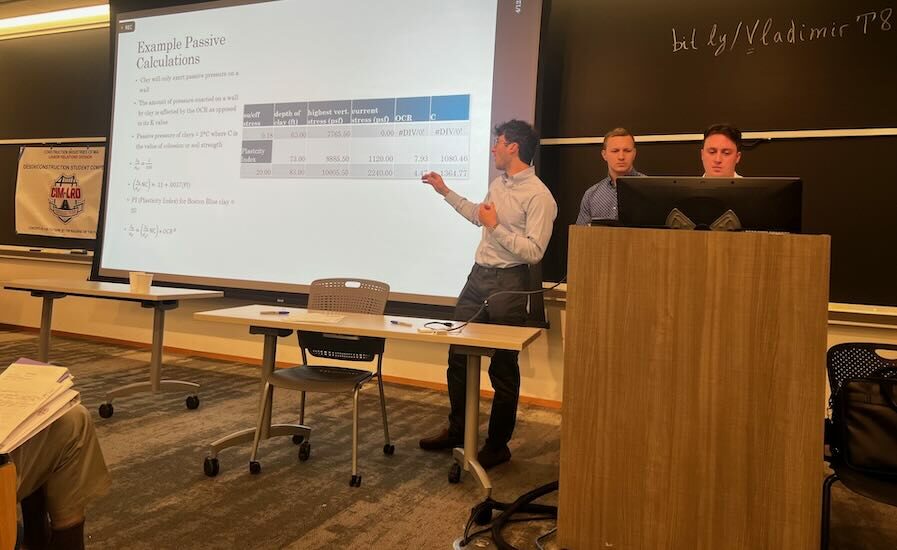
Student Designers Tackle Civil Engineering Challenge

Designing, pricing and scheduling a new subway station in a dense urban setting would be difficult for even the most veteran design team to tackle, let alone a team trying to also meet deadlines for their year-long senior capstone projects.
“Our time management skills were tested,” says Lucas Bernstein a member of a team from the University of New Hampshire, which beat teams from six other New England colleges and universities competing for $120,000 in prize money earlier this month during a civil engineering design competition at Tufts University in Medford, Mass.
Bernstein was grateful for the opportunity to develop “real-world skills, applying material learned in the classroom to a project in my field of study and … to represent my school.”
The third annual event—organized by the Labor Relations Division of the Construction Industries of Massachusetts, a collective for the heavy construction industry whose membership is comprised of union road and bridge builders including laborers, operating engineers and carpenters—paired the student teams with industry coaches. In the fall, the teams were given a package prepared by Wentworth School of Technology professor Jim Lambrechts, prompting them to design a hypothetical plan to extend the Massachusetts Bay Transportation Authority’s Blue Line westward.
The teams worked on their presentations in conjunction with their assigned industry coach or coaches before pitching industry judges April 12 at Tufts.
“All of the teams did an impressive job identifying the engineering and construction challenges involved and clearly gained meaningful, practical insight into the industry,” says Rob Pine, vice president of operations at Skanska USA Civil, who served as a judge. “It was rewarding to see how this experience prepares the next generation of professionals—not just technically, but in how they think, collaborate, and communicate.”
Teams from the University of New Hampshire, Tufts, University of Connecticut, Northeastern University, University of Vermont, University of Massachusetts Lowell and Springfield Technical Community College pitched the judges before UNH took the first-place prize of $15,000. Tufts received $10,000 for second place, while the remaining schools won $5,000 each.
Pine said that while the competition was close, “UNH stood out with their practical design and construction approach, combining cut-and-cover and traditional tunneling to develop a constructible solution for building an MBTA station in a dense urban setting.”
The UNH squad (Bernstein, Daniel Bartus and Tyler Beresford) was coached by Fei Han, assistant professor of civil and environmental engineering at UNH, and staff from design firm SPS New England, who met with the students bi-weekly.
“They were able to keep us in line when our ideas were unrealistic and were a huge help in developing our final estimate,” says Bernstein, who also thanked Han for helping him calculate the forces on a slurry wall, “which was quite complicated given the soil profile we were dealing with. The visual I was able to make from these calculations definitely set us apart from other groups and helped us win the competition.”
Co-founder John R. Roma, 80—who runs has run his own consultancy after retiring from a deep foundation construction career with firms such as Skanska and Weeks Marine—conceived of the competition as a way to “attract students into the heavy construction industry” after listening to his friend and co-founder, Lambrechts, talk about his vision for extending the MBTA Blue Line westward.
“Every student who has been involved over the past three years,” Roma says, “has given nothing but rave reviews with the process. The most-heard comment I have heard from older folks in the industry is that they wished they had this when they were going through school.”
To make the competition even more realistic this year, the teams were informed at the end of the day that the CIM-LRD executive committee issued a change order, with an additional $10,000 going to each school. The money was divided equally among the student participants.
Besides Pine, the other judges this year included Dave Puser, the executive director of the Moles; Brendan Casey, an MBTA project manager; Aaron Lewis, a senior principal at SGH; Joe Allegro, owner of Allegro Construction Services and Tom Day, director of estimating at Skanska USA Civil Northeast.
Before the winning teams were announced, Day—who was given the same package as the students this past fall—provided his “independent professional evaluation” to the group.
Lucy Jen, professor of the practice at Tufts University and principal geotechnical engineer at Jen Geotechnical LLC, served as an industry coach for the second-place Tufts team along with Alison Bulman from Skanska. Jen, who also coached Tufts last year, said the competition is a great opportunity for civil engineering undergraduate students to apply “what they’ve learned as well as exposing them to other aspects of the design and construction process not covered in their undergraduate curriculum.”
She added that it’s an “excellent springboard for undergraduates entering engineering practice” because it helps them learn to “work in teams, apply what they’ve learned in classes, learn new skillsets, perfect their presentation skills, identify their interests and appreciate different approaches by other teams.”
Post a Comment
You must be logged in to post a comment.





